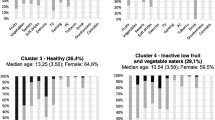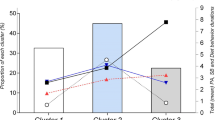Abstract
Aim
The aims of this study were to identify clustering of behaviours in young adolescents and to analyse differences in food intake according to clusters.
Subject and methods
A cross-sectional study was carried out on adolescents’ behaviours comprising 2,160 adolescents aged 13 years attending schools of Porto, Portugal. We used data of 875 girls and 737 boys with complete information for all variables considered in the cluster definition (tobacco and alcohol use, sport activities, fruit intake, daily sleep hours). The average method was used to find the natural structure of clusters.
Results
We identified three clusters: cluster 1 characterized by never smokers and never drinkers represented those with higher intake of fruits and lower intake of soft drinks. Cluster 2 comprised essentially tobacco and alcohol experimenters and was almost similar to cluster 1 regarding the other characteristics. Cluster 3 represented mostly regular smokers and drinkers, and those with the lowest daily sport activities, the lowest number of daily sleep hours, the lowest mean of fruit consumption and the highest intake of sweets and soft drinks.
Conclusion
Our findings show that even in the early stages of adolescence there is a cluster of smoking, alcohol use and food intake, providing further evidence of the clustering of unhealthy behaviours.

Similar content being viewed by others
References
Bartlett R, Holditch-Davis D, Belyea M (2007) Problem behaviors in adolescents. Pediatr Nurs 33:13–18
Birch LL, Fisher JO (1998) Development of eating behaviors among children and adolescents. Pediatrics 101:539–549
Boden-Albala B, Sacco RL (2000) Lifestyle factors and stroke risk: exercise, alcohol, diet, obesity, smoking, drug use, and stress. Curr Atheroscler Rep 2:160–166
Breiman L, Friedman J, Stone CJ, Olshen RA (1984) Classification and regression trees. Wadsworth, Belmont
Burke V, Milligan RA, Beilin LJ, Dunbar D, Spencer M, Balde E, Gracey MP (1997) Clustering of health-related behaviors among 18-year-old Australians. Prev Med 26:724–733
Cardi M, Munk N, Zanjani F, Kruger T, Schaie KW, Willis SL (2009) Health behavior risk factors across age as predictors of cardiovascular disease diagnosis. J Aging Health 21:759–775
Eaton DK, Kann L, Kinchen S, Shanklin S, Ross J, Hawkins J, Harris WA, Lowry R, McManus T, Chyen D, Lim C, Brener ND, Wechsler H, CDC (2008) Youth risk behavior surveillance—United States, 2007. MMWR Surveill Summ 57:1–131
Gidding SS, Dennison BA, Birch LL, Daniels SR, Gillman MW, Lichtenstein AH, Rattay KT, Steinberger J, Stettler N, Van Horn L, American Heart Association (2006) Dietary recommendations for children and adolescents: a guide for practitioners. Pediatrics 117:544–559
Gorely T, Marshall SJ, Biddle SJH, Cameron N (2007) Patterns of sedentary behaviour and physical activity among adolescents in the United Kingdom: project STIL. J Behav Med 30:521–531
Guilamo-Ramos V, Litardo H, Jaccard J (2005) Prevention programs for reducing adolescent problem behaviors: implications of the co-occurrence of problem behaviors in adolescence. J Adolesc Health 36:82–86
He K, Kramer E, Houser RF, Chomitz VR, Hacker KA (2004) Defining and understanding healthy lifestyles choices for adolescents. J Adolesc Health 35:26–33
Jessor RA (1984) Adolescent development and behavioral health. In: Matarazzo J, Weiss S, Herd J, Miller N, Weiss J (eds) Behavioural health: a handbook of health enhancement and disease prevention. Wiley, New York, pp 69–90
Kaufman L, Rousseeuw PJ (1990) Finding groups in data: an introduction to cluster analysis. Wiley, New York
Lawlor DA, O’Callaghan MJ, Mamun AA, Williams GM, Bor W, Najman JM (2005) Socioeconomic position, cognitive function, and clustering of cardiovascular risk factors in adolescence: findings from the Mater University study of pregnancy and its outcomes. Psychosom Med 67:862–868
Lopes C (2000) Reproducibility and validity of semi-quantitative food frequency questionnaire. In: diet and myocardial infarction: a community-based case-control study (in Portuguese). Ph.D. thesis, Medical School Porto, University of Porto
Lopes C, Aro A, Azevedo A, Ramos E, Barros H (2007) Intake and adipose tissue composition of fatty acids and risk of myocardial infarction in a male Portuguese community sample. J Am Diet Assoc 107:276–286
Ma J, Betts NM, Hampl JS (2000) Clustering of lifestyle behaviors: the relationship cigarette smoking, alcohol consumption, and dietary intake. Am J Health Promot 15:107–117
Miller JW, Naimi TS, Brewer RD, Jones SE (2007) Binge drinking and associated health risk behaviors among high school students. Pediatrics 119:76–85
Nelson M, Gordon-Larsen P, Adair L, Popkin BM (2005) Adolescent physical activity and sedentary behavior: patterning and long-term maintenance. Am J Prev Med 28:259–266
Papadopoulou SK, Barboukis V, Dalkiranis A, Hassapidou M, Petridou A, Mougios V (2008) Validation of a questionnaire assessing food frequency and nutritional intake in Greek adolescents. Int J Food Sci Nutr 59:148–154
R Development Core Team (2008) R: A language and environment for statistical computing. R Foundation for Statistical Computing, Vienna
Ramos E, Barros H (2007) Family and school determinants of overweight in 13-year-old Portuguese adolescents. Acta Paediatr 96:281–286
Rockett HRH, Breitenbach M, Frazier AL, Witschi J, Wolf AM, Field AE, Colditz GA (1997) Validation of a youth/adolescent food frequency questionnaire. Prev Med 26:808–816
Savage JS, Fisher JO, Birch LL (2007) Parental influence on eating behavior: conception to adolescence. J Law Med Ethics 35:22–34
Talashek ML, Norr KF, Dancy BL (2003) Building teen power for sexual health. J Transcult Nurs 14:207–216
te Velde SJ, De Bourdeaudhuij I, Thorsdottir I, Rasmussen M, Hagströmer M, Klepp K-I, Brug J (2007) Patterns in sedentary and exercise behaviors and associations with overweight in 9-14-year-old boys and girls—a cross-sectional study. BMC Public Health 7:16
Wu TY, Rose SE, Bancroft RN (2006) Gender differences in health risk behaviors and physical activity among middle school students. J Sch Nurs 22:25–31
Acknowledgements
We gratefully acknowledge grants from Fundação para a Ciência e Tecnologia (POCTI/SAU-ESP/62399/2004). Sílvia Fraga (SFRH/BD/44408/2008) and Diogo Costa (SFRH/BD/66388/2009) have a Ph.D. grant from Fundação para a Ciência e Tecnologia.
Conflict of interest
The authors declare that they have no conflict of interest.
Author information
Authors and Affiliations
Corresponding author
Rights and permissions
About this article
Cite this article
Fraga, S., Severo, M., Costa, D. et al. Clustering behaviours among 13-year-old Portuguese adolescents. J Public Health 19 (Suppl 1), 21–27 (2011). https://doi.org/10.1007/s10389-010-0376-0
Received:
Accepted:
Published:
Issue Date:
DOI: https://doi.org/10.1007/s10389-010-0376-0




